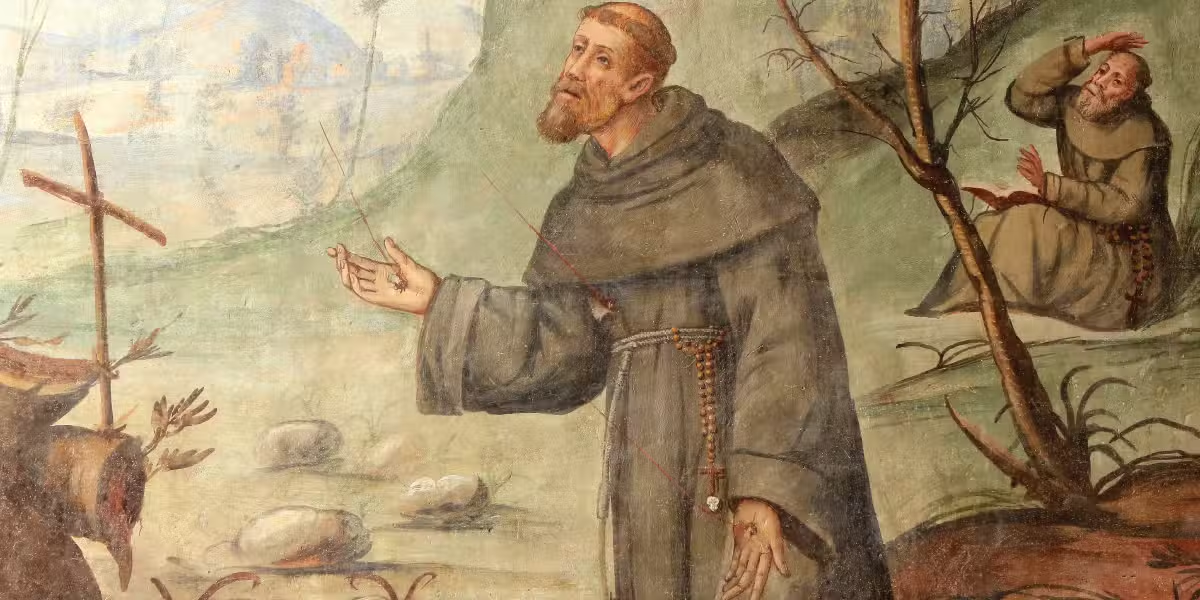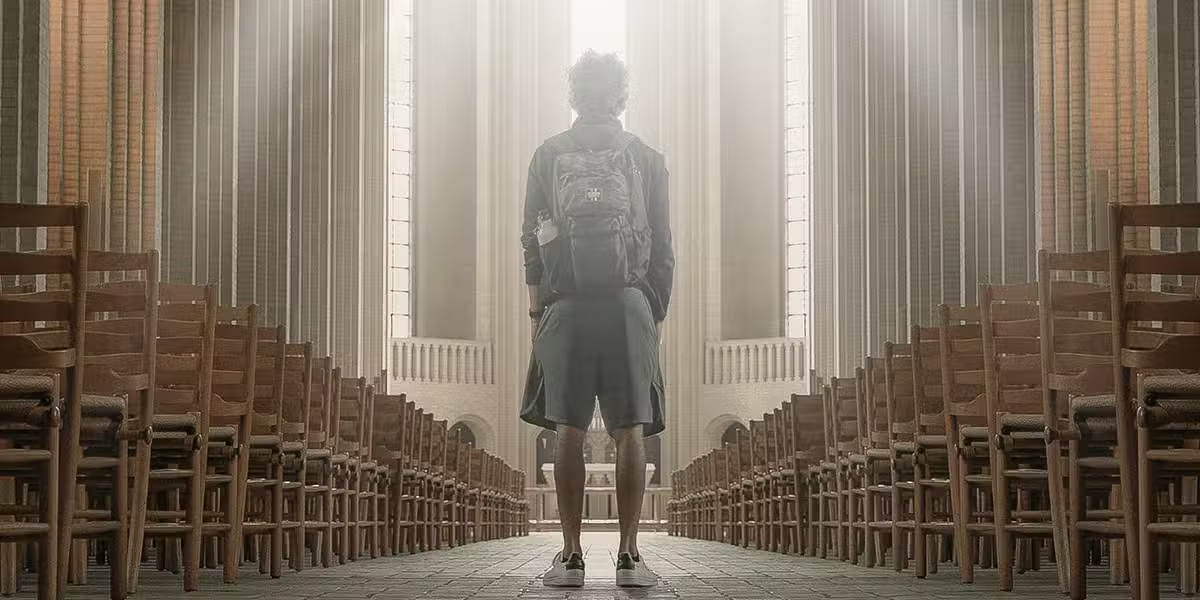God marked Francis in soul and body with the total gift of Christ in his suffering and death on the cross.
Francis of Assisi was a man who wanted no possessions yet accepted the gift of a mountain in Italy. He came to that mountain to find solitude but carried with him the problems of the outside world and his new community of brothers. What happened there was something Francis was reluctant to share. But the event forever identifies him.
This year, Franciscans mark the 800th anniversary of God’s gift to Francis of the stigmata—the marks of the wounds of the crucified Christ. As Pope Francis told a group of Franciscans in April: “The stigmata are one of the most eloquent signs the Lord has granted over the course of the centuries, to brothers and sisters in faith. . . .
“They remind everyone in the holy people of God of the pain suffered by Jesus in his own flesh for our love and salvation; but they are also a sign of the paschal victory: It is indeed through the wounds that the mercy of the crucified and risen one, as if through channels, flows towards us.”
A Place of Solitude
The Franciscan sanctuary on Mount La Verna, in a remote, forested area in central Italy’s Tuscany region, is the focus of this year’s commemoration. To reach it, pilgrim buses ascend a twisting route to the mountaintop, where there is a cluster of buildings—a church, several chapels, a pilgrim hostel, and primitive caves—and a spectacular vista of the surrounding valleys and mountains.
Snowbound in winter, often covered with a blanket of fog, prey to summer storms, but capable of rewarding the pilgrim with brilliant skies and breathtaking views, the sanctuary of La Verna still captures the solitude that Francis sought 800 years ago.
Like the cross, Mount La Verna is itself a paradox. In 1213, Francis was traveling with his companion and secretary, Brother Leo, through this region. He stopped at the Castle of San Leone, where a feast was in progress, hosted by Count Orlando Cattani of Chiusi. Francis favored the guests with a sermon, and the count was so impressed that he offered the Poor Man of Assisi the gift of the mountain as a place of solitude and prayer. A document from May 8, 1213, attests of this remarkable gift—to a man who wished to own nothing!
Francis visited Mount La Verna six times between that first visit in 1213 and 1224. His final visit came during what was known as the “Lent of St. Michael,” a time of fasting and prayer for 40 days before the feast of the Archangel Michael.
In his recent, excellent study: Francis of Assisi: His Life, Vision and Companions (London: Reaktion Books, 2023), Father Michael F. Cusato, Franciscan historian, describes the man who made the painstaking journey to La Verna that fall: “Not only were his ailments beginning to take their toll upon his eyes and stomach, but he also had to witness . . . the slow drifting of a growing segment of the fraternity away from the primordial ideals which he considered to be of divine revelation and the way of life that God had wanted of him and his friars.”
Cusato calls the last three years of Francis’ life, 1223–1226, “The Years of Decline.” Francis had finished revising the formal rule of life for his order, approved by Pope Honorius III in November 1223. Despite having resigned the day-to-day administration of the order, many still looked to him as guardian of the order’s “spiritual vision.”
Francis carried another burden, according to Cusato, who has made an extensive study of Francis’ historic encounter with the Muslim leader, Sultan Malik-al Kamil, in 1219. This meeting, amid the bloody conflict known as the Fourth Crusade, made a lasting impression on Francis. Cusato believes that the announcement of Pope Honorius III, in April 1223, of another campaign against the Muslim forces “profoundly disturbed and unsettled Francis.” What would a new round of violence mean for the sultan, whom Francis had befriended?
This, then, was the man who came to La Verna in the fall of 1224.
The First Chroniclers
The stigmata itself was a profoundly private experience. The saint allowed only a few followers to see and care for the wounds—which actively bled and caused real pain. Our knowledge of the event is based on their witness, and the testimony of those who saw the body of Francis after his death.
The oldest account of the stigmata comes from Francis’ first biographer, Thomas of Celano, writing in The Life of St. Francis, two years after the saint’s death:
“While he was staying in that hermitage called La Verna, after the place where it is located, two years prior to the time that he returned his soul to heaven, he saw in the vision of God a man, having six wings like a Seraph, standing over him, arms extended and feet joined, affixed to a cross. Two of his wings were raised up, two were stretched out over his head as if for flight, and two covered his whole body.”

The resulting physical manifestation is also described by Celano: “His hands and his feet seemed to be pierced through the middle by nails, with the heads of the nails appearing on the inner part of his hands and on the upper part of his feet, and their points protruding on opposite sides. Those marks on the inside of his hands were round, but rather oblong on the outside; and small pieces of flesh were visible like the points of nails, bent over and flattened, extending beyond the flesh around them.”
Celano relates that similar marks appeared on Francis’ feet: “His right side was marked with an oblong scar, as if pierced with a lance, and this often dripped blood, so that his tunic and undergarments were frequently stained with his holy blood.”
Christ Crucified
Despite the physical pain of the stigmata, Celano tells us Francis “rejoiced at the gracious way Christ looked upon him under the appearance of the Seraph, but the fact that the Seraph was fastened to a cross pierced [Francis’] soul with a sword of compassionate sorrow.”
Cusato uses this reference to Christ’s crucifixion to provide an understanding of Francis’ mystical experience.
The image of Francis, receiving the wounds of Christ from what Celano calls a “Seraph,” can be “unwittingly misleading,” Cusato says. The popular depiction suggests a “seraphim,” one of the nine choirs of angels, as depicted in Isaiah 6:1–2, where the prophet has a vision of “seraphim” with six wings.
But Cusato cites two other biblical texts underlying Celano’s use of the term Seraph. In Numbers 21:4–8, God instructs Moses to fashion a bronze serpent on a pole, so that those bitten by “saraph serpents” may look at it and be healed.
Then in John’s Gospel (3:13–17), Jesus tells Nicodemus, “Just as Moses lifted up the serpent in the desert, so must the Son of Man be lifted up, so that ev-eryone who believes in him may have eternal life.”
“The Seraph, in other words,” Cusato contends, “is not really an angelic figure; rather it is Christ himself, crucified for the healing of the human race.” Cusato concludes that “Francis had internalized so deeply and profoundly the image of the crucified Christ on the cross that it literally, physically exploded out of his psyche and onto his own flesh, marking him with the wounds of Christ, the stigmata. . . . Francis became what and to whom he was praying.”
A Gift for Francis’ Followers
We have inherited eight centuries of accounts and legends surrounding the stigmata. We have the teaching of St. Bonaventure and many others. Even Church art depicting the crucifixion bears the influence of Francis’ embrace of the crucified Christ. Art historian Stella Grace Lyons writes that, after Francis, “Artists responded by painting increasingly realistic scenes of Jesus’ vulnerability—at birth and at death.” Think of the contrast between the crucifix of San Damiano, with its serene, victorious Christ, risen and ascending to heaven, and any one of the countless graphic crucifixion scenes in art or film.
What can Francis’ experience mean for 21st-century Franciscans? To understand it, we need to look beyond the event commemorated this year.
Francis’ whole life led to La Verna. His youth in Assisi was marked by frequent violence. He took part in bloody conflict in the ill-fated war of Assisi against Perugia in 1202, which journalist Paul Moses believes—along with Francis’ yearlong imprisonment—caused what today we know as post-traumatic stress disorder. Francis’ conversion—through long months of isolation and prayer—did not happen in one moment of insight.
Rather, God led Francis in and through the depths of suffering to come to know Christ. As Francis himself tells us in his Testament, God led him to embrace the suffering, crucified Christ, in serving lepers, the outcasts of his time. And finally, on Mount La Verna, God marked Francis in soul and body with the total gift of Christ in his suffering and death on the cross.
Knowing God and Himself
I believe there is a beautiful connection to the event of the stigmata found in an early collection called The Deeds of Blessed Francis and His Companions (better known in its Italian translation, The Little Flowers of St. Francis), written more than a century after Francis’ death.
In chapter 9, Francis comes to Mount La Verna in the fall of 1224 with a few companions. He builds a small hut and tells Brother Leo not to disturb him—save to bring bread and water once a day and come at night for matins.
But Leo can’t resist eavesdropping on Francis. One early morning, Leo overhears him praying, “Who are you, my most dear God, and who am I, a worm and your little servant?” Leo’s presence disturbs Francis. He first reprimands Leo, but then agrees to explain what Leo overheard. Francis relates that “two lights were opened for me in what you saw and heard: One, a knowledge of the Creator, and the other, a knowledge of myself.” Francis shares how God showed him “the abyss of infinite divine goodness and the depths of my own vileness.”
Francis knew himself and his own journey through violence, human weakness, and sin. As he prayed, “Who am I?” the legend recounts that God consoled Francis and promised that “in a few days, on this mountain God will perform an astonishing miracle which the whole world will admire.”
Making Francis’ Prayer Our Own
The two questions from the prayer of Francis overheard by Brother Leo are, I believe, one of the simplest ways to approach God. We open ourselves and allow God to answer that first question, Who are you, my God? Reflecting on the Scriptures or nature—as Francis often did—will prepare us to hear who God is in our lives.
For Francis, the answer came dramatically in the vision of the crucified Christ in the form of the “seraph.”
For us, we can trust that—in all our “crosses”—our suffering, our weakness, and even in our sins, God will respond in love. Despite the suffering caused by the stigmata, Francis lived his final days with an answer to that second question, Who am I?
The answer God promises to give to you or me will be unique to each of us. But in faithfully imitating the way of St. Francis of Assisi, we can be assured that God will show us how we are loved, and what our response can be.









2 thoughts on “The Stigmata of St. Francis: Embracing the Crucified Christ ”
Thank you for this authentic Franciscan essay. I have to go back to the little flowers. I sometimes think of them as fairy tales
Thanks for this beautiful insight into St Francis and the stigmata..St Francis pray for us.